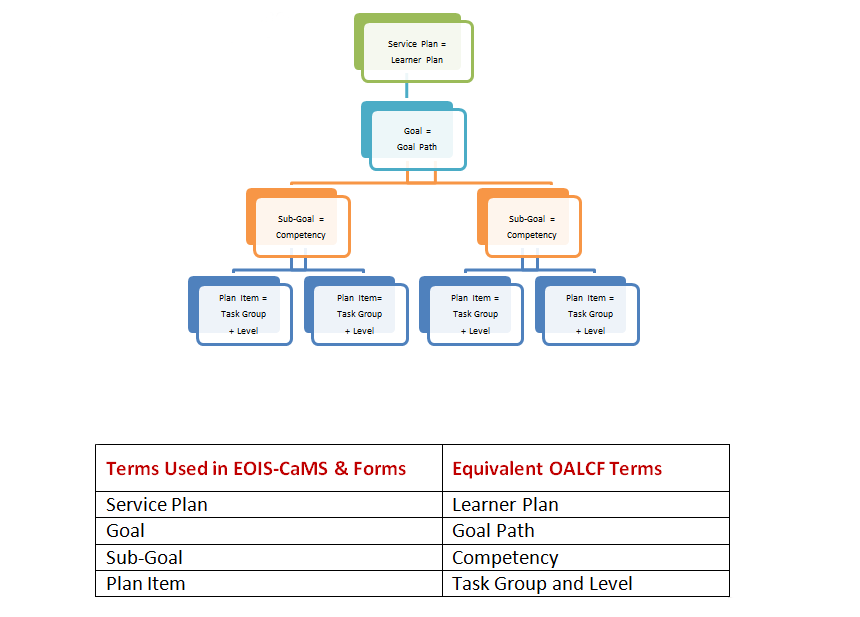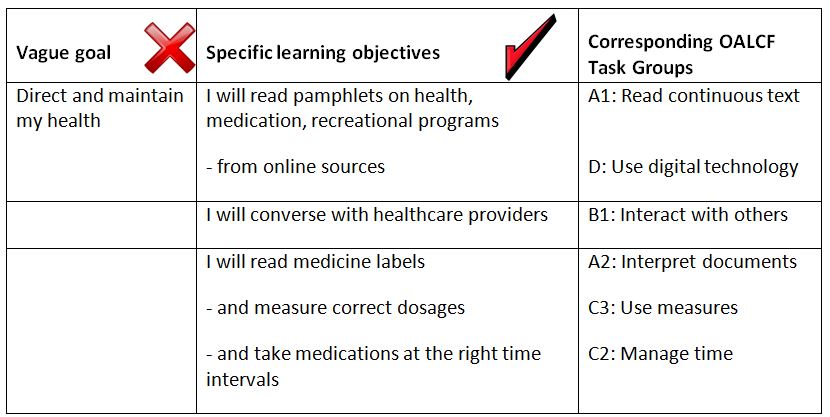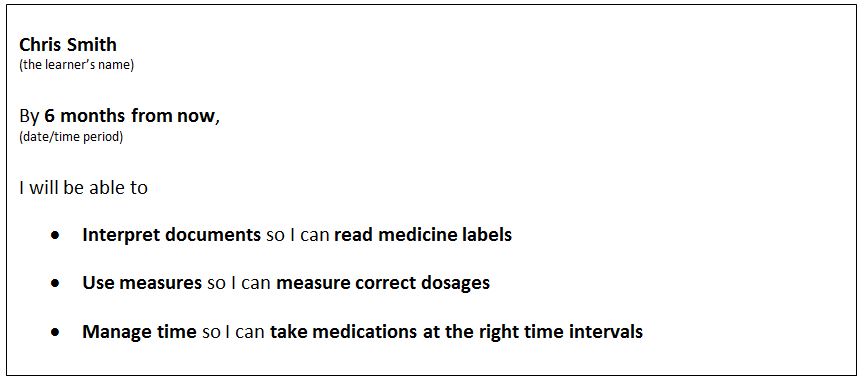Employment Ontario Service Plans and Learner Plans
All Employment Ontario (EO) service providers, including Literacy and Basic Skills providers, create plans that detail the benefits and services they will deliver to meet clients’ needs. Within Employment Ontario and the Employment Ontario Information System Case Management System(EOIS-CaMS) these are called service plans. Service plans detail the client’s
- goal
- sub-goals
- plan items
For the Literacy and Basic Skills (LBS) field, the Ministry of Training, Colleges and Universities (MTCU) has created service plans in EOIS-CaMS that support the Ontario Adult Literacy Curriculum Framework (OALCF). Terms used in Employment Ontario, EOIS-CaMS, the LBS Participant Registration Form and the Learner Plans are different than those used in the OALCF.
The table and diagram below show the relationship between terms.

Service Plans
All Employment Ontario service providers create plans for individual participants that detail the benefits and services that the service provider can deliver in order to meet clients’ needs. Employment Ontario refers to this type of plan as a service plan, although in we also refer to them as Learner Plans in LBS.
“The service plan is a system tool that allows an Employment Ontario service provider to plan and manage the delivery of services and activities to help a client achieve a specific goal.” (EOIS-CaMS: Service Provider User Guide, Chapter 8B: Service Plan Management for Literacy and Basic Skills, Version 2.6 April 2019)
Goals
The primary reason for the creation of any service plan is to enable a client to achieve an overall plan goal. In the OALCF, learners’ goals are expressed as goal paths. EOIS-CaMS “goals” have been configured for the five LBS goal paths:
- Independence
- Employment
- Adult Secondary School Credit
- Postsecondary Education
- Apprenticeship
Sub-Goals
The goal or goal path can be broken down into more manageable steps to assist the leaner in achieving the goal. These steps are known as sub-goals, which typically consist of one or more scheduled activities or plan items. For LBS, the sub-goals are the LBS competencies, learning activities, training supports and referrals out to community resources or other programs and services.
EOIS –CaMs sub-goals:
- Competency A. Find and Use Information
- Competency B. Communicate Ideas and Information
- Competency C. Understand and Use Numbers
- Competency D. Use Digital Technology
- Competency E. Manage Learning
- Competency F. Engage with Others
- Learning Activities
- Training Supports
- Referrals out to community resources or other programs and services
Plan Items
Sub-goals usually have one or more plan items. Plan items are the actions and/or the achievements that must be fulfilled to meet the learners needs. In LBS, Competency based plan items are representative of the task groups and level indicators from the OALCF with the finishing point attaining a Milestone. The successful completion of some or all applicable plan items is required for a learner to achieve a sub-goal.
- For complete step-by-step directions on creating the LBS service plan in EOIS-CaMS, see Employment Ontario Information System (EOIS) Case Management System Service Provider User Guide Chapter 8B: Service Plan Management for Literacy and Basic Skills.
Learner Plan Templates (Service Plans)
In EOIS-CaMS, “the ministry has created service plan templates based on the relevant program or service guidelines. The templates include a predefined set of sub-goals, which include plan items. Service providers must use these templates when creating service plans; however, a service plan created from a template can still be customized to meet the individual requirements of a specific client, thus providing even greater flexibility.” (EOIS-CaMS: Service Provider User Guide, Chapter 8B: Service Plan Management for Literacy and Basic Skills, Version 2.6 April 2019)
The EOIS CaMS Service Plan Template for LBS contains two main sections: the Client Summary and LBS the Learner Plan. “The Learner Plan describes the learning and program elements that prepare learners for their next steps beyond the LBS program. It includes the learner’s goal, background information, assessment results, tasks, learning activities, program duration, additional supports required by the learner as well as referral results. It organizes information in a common format for ease of use between program providers.” (EOIS-CaMS: Service Provider User Guide, Chapter 8B: Service Plan Management for Literacy and Basic Skills, Version 2.6 April 2019)
Note: LBS practitioners must be authorized to enter information into, and download from, EOIS-CaMS. Authorization and user codes are arranged by your agency’s Ministry of Training, Colleges and Universities Employment and Training Consultant (ETC) following a request from your agency’s Service Provider Registration Authority (SPRA).
Learner Acceptance of Plan
For a service plan to be activated, the learner plan template must be accepted by the learner. You need to keep a copy in the learner’s file and provide a copy to the learner.
Learners need to understand the contents of their plans in order to accept and agree to them. Keep in mind that the plans are for the learners and that it helps them “own” their learning. For some learners understanding all the steps in their plan and navigating many pages of documents may be difficult. They may feel that there is too much information or that the forms are too complicated. They may have difficulty understanding the language of the OALCF that is presented on the EOIS CaMS Learner Plan.
One way to personalize the Service/Learner Plan in EOIS CaMS is to use the Comments sections of each Plan Item to provide more learner specific details than just the Task Group and Level Indicator. This is especially true in the Learning Activities sub-goals, where you can choose from preset activities or create Custom Plan Items. You may change the name of Learning Activity, Custom Plan Items to be learner specific. Add the specific learning activities that the learner will undertake to the Comments using language that they may better understand or that relates to their goal.
Some LBS agencies prefer using their own learner plan documents to help the learners understand the details of their future training, for example:
- The Literacy Council York-Simcoe has developed learning plans for each of the goal paths they serve. Their Learning Plans have all the applicable milestones offered from drop-down menus in an Excel spreadsheet.
- The Adult Learning Centre for Cochrane and Iroquois Falls has a much more detailed template. Their LBS Learning Plan and Assignment Tracking Sheet, in the Sample Forms section, lists any of the resources/learning activities that they commonly use. The practitioner completing the form just removes rows that are not applicable to the learner’s plan. Other resources and activities can be added in new rows. As well as information needed to set up the learner’s plan, there are spaces to track the learners training progress and assessments as they move through the program.
Some practitioners find that mind-maps or other visuals help the learner to visualize the steps to their plan and the links to their goal. Two examples of this are the Key Tasks Learning Form and the Learning Activities Step Plan used by Barrie Literacy Council which can be found in the Sample Forms section.
Whatever method you use, remember, this is an essential step in the adult learning process and worth the time spent helping learners understand and “buy into” their plan.
Building a Service Plan/Learner Plan in EOIS-CaMS
The successful creation of a service plan requires the following steps to be performed in sequence.
- Create a service plan using the LBS Participant Registration form. The Participant Registration is one of the documents required in each learner file (Literacy and Basic Skills: Service Provider Program Guidelines). For help in understanding how to complete the Employment Ontario Literacy and Basic Skills (LBS) Participant Registration form, review the how-to guide offered by CESBA at http://cesba.com/wp-content/uploads/2018/03/How-to-Fill-Out-the-PRF.pdf.
- In EOIS-CaMS:
- Create a client summary from the information on pages 1, 2 and 4 of the completed LBS Participant Registration Form
- Add sub-goals and plan items to sub-goals from the information on page 5 of the completed LBS Participant Registration Form
- Submit service plan for approval
- Create Plan Summary
- Download Plan Summary to a secure computer location
- Make any additions or changes required and print the Plan Summary, now titled as Learner Plan.
- Present Learner Plan to the learner for acceptance. Provide learner with a copy.
- In EOIS-CaMS:
- Upload any changes made to the Learner Plan/Plan Summary
- Record acceptance (or rejection) of plan summary
- Place a copy in the learner’s file.
Setting the Learning Objectives
Learning objective: A statement in specific and measurable terms that describes what the learner will know or be able to do as a result of engaging in a learning activity.
Ohio University,
Heritage College of Osteopathic Medicine
The first step in setting up a Learner Plan is setting the objectives. Learning objectives or learning outcomes describe what the learners will be able to do by the end of their Literacy and Basic Skills (LBS) plan with your agency.
Learning objectives are drawn from the learner’s goal, the goal path requirements, and the learner assessments. These objectives direct the content, how it will be presented and the expected outcome. They help learners see how specific learning activities meet their learning needs.
Wording objectives from the learner’s perspective personalizes the objectives, for example, wording the objective as “I will” rather than “the learner will” or “you will.”
Objectives should clearly state what the learners will be able to do or demonstrate as a result of their LBS training. Objectives should not be vague. Instead they should be concrete and measureable. In the following chart, we show an example of a vague objective for a learner on the independence goal path. This is followed by examples of better and more specific learning objectives.

As you can see from the chart, once you have specific, measureable learning objectives, you can relate these to the Ontario Adult Literacy Curriculum Framework (OALCF) competencies and task groups. The competencies that the learner needs to work on are the sub-goals and the task groups and level indicators are the plan items you use to populate the LBS Learner Plan for the EOIS-CaMS system.
The templates created by MTCU provide sub-goals and plan items in the language of the OALCF rather than as learning outcomes specific to the individual learner. Because of this, many programs have developed ways to document the distinctive outcomes for each learner. These may be simple statements such as those in the following forms or more detailed Learner Plan add-ons.

Filled in this becomes

The learning outcomes can also be incorporated into a larger format that includes learning objective tasks and overall timelines, such as Literacy Council York-Simcoe’s Literacy Program Learning Plan in the Sample Forms section. The sample is completed to show Jane Doe’s plan for the employment goal path, working mostly on Understand and Use Numbers Competency C, Level 2.




